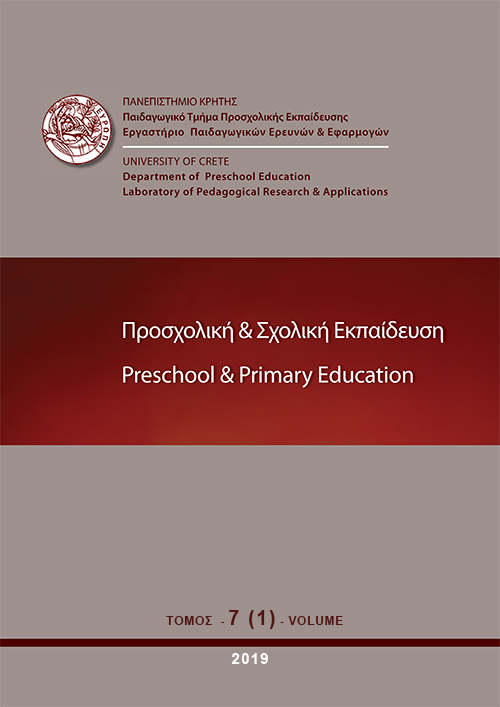What aspects of the home literacy environment differentiate Chinese children at risk for reading difficulties from their not at risk controls?
Περίληψη
We examined what aspects of the home literacy environment (formal home literacy activities, informal home literacy activities, access to literacy resources, age of onset of literacy instruction, child’s interest in reading, and parents’ expectations) differentiate Chinese children at risk for reading difficulties from their not-at-risk controls. Eighteen children from Jining, China, who were at risk for reading difficulties and 32 not-at-risk controls participated in the study. Their parents also participated in the study by filling out a home literacy questionnaire, by recording the daily parent-child reading activities (diary), and by completing the Children’s Title Recognition Checklist. Group comparisons revealed significant differences only in items measuring children’s access to literacy resources and reading interest. Results of discriminant function analyses further showed that the home literacy environment variables could discriminate well between the children at risk for reading difficulties and their controls. Taken together, our findings suggest that to the extent environment plays a role in reading difficulties in Chinese, this should be traced to factors such as child’s interest in reading and access to literacy resources.
Λεπτομέρειες άρθρου
- Πώς να δημιουργήσετε Αναφορές
-
Zhang, S. Z., Georgiou, G. K., & Shu, H. (2019). What aspects of the home literacy environment differentiate Chinese children at risk for reading difficulties from their not at risk controls?. Preschool and Primary Education, 7(1), 1–18. https://doi.org/10.12681/ppej.18868
- Τεύχος
- Τόμ. 7 Αρ. 1 (2019)
- Ενότητα
- Άρθρα

Αυτή η εργασία είναι αδειοδοτημένη υπό το CC Αναφορά Δημιουργού – Μη Εμπορική Χρήση – Παρόμοια Διανομή 4.0.
Οι συγγραφείς των άρθρων που δημοσιεύονται στο ΠΡΟΣΧΟΛΙΚΗ & ΣΧΟΛΙΚΗ ΕΚΠΑΙΔΕΥΣΗ διατηρούν τα δικαιώματα πνευματικής ιδιοκτησίας επί των άρθρων τους, δίνοντας στο περιοδικό το δικαίωμα της πρώτης δημοσίευσης. Άρθρα που δημοσιεύονται στο ΠΡΟΣΧΟΛΙΚΗ & ΣΧΟΛΙΚΗ ΕΚΠΑΙΔΕΥΣΗ διατίθενται με άδεια Creative Commons 3.0 και σύμφωνα με την άδεια μπορούν να χρησιμοποιούνται ελεύθερα, με αναφορά στο/στη συγγραφέα και στην πρώτη δημοσίευση για μη κερδοσκοπικούς σκοπούς και με δικαίωμα τροποποίησης μόνον με παρόμοια διανομή (αν αναμείξετε, τροποποιήσετε, ή δημιουργήσετε πάνω στο υλικό, πρέπει να διανείμετε τις δικές σας συνεισφορές υπό την ίδια άδεια όπως και το πρωτότυπο). To Εργαστήριο Παιδαγωγικών Ερευνών και Εφαρμογών του Παιδαγωγικού Τμήματος Προσχολικής Εκπαίδευσης του Πανεπιστημίου Κρήτης και το Εθνικό Κέντρο Τεκμηρίωσης διατηρούν το δικαίωμα να δημοσιεύουν, να αναπαραγάγουν, να παρουσιάζουν στο κοινό, να διανέμουν και χρησιμοποιούν άρθρα που δημοσιεύονται στο ΠΡΟΣΧΟΛΙΚΗ & ΣΧΟΛΙΚΗ ΕΚΠΑΙΔΕΥΣΗ σε οποιοδήποτε μέσο και μορφή είτε μεμονωμένα είτε ως μέρη συλλογικών έργων, για όλο το χρόνο διάρκειας προστασίας της πνευματικής ιδιοκτησίας και για όλες τις χώρες του κόσμου. Αυτό περιλαμβάνει ενδεικτικά και όχι αποκλειστικά, το δικαίωμα δημοσίευσης των άρθρων σε τεύχη του περιοδικού ΠΡΟΣΧΟΛΙΚΗ & ΣΧΟΛΙΚΗ ΕΚΠΑΙΔΕΥΣΗ, αναπαραγωγής και διανομής μεμονωμένων αντιγράφων των άρθρων, αναπαραγωγής ολόκληρων των άρθρων σε άλλη έκδοση του Εργαστηρίου Παιδαγωγικών Ερευνών και Εφαρμογών του Παιδαγωγικού Τμήματος Προσχολικής Εκπαίδευσης του Πανεπιστημίου Κρήτης και του Εθνικού Κέντρου Τεκμηρίωσης και αναπαραγωγής και διανομής των άρθρων ή περίληψης αυτών με χρήση πληροφορικού συστήματος αποθετηρίου.



